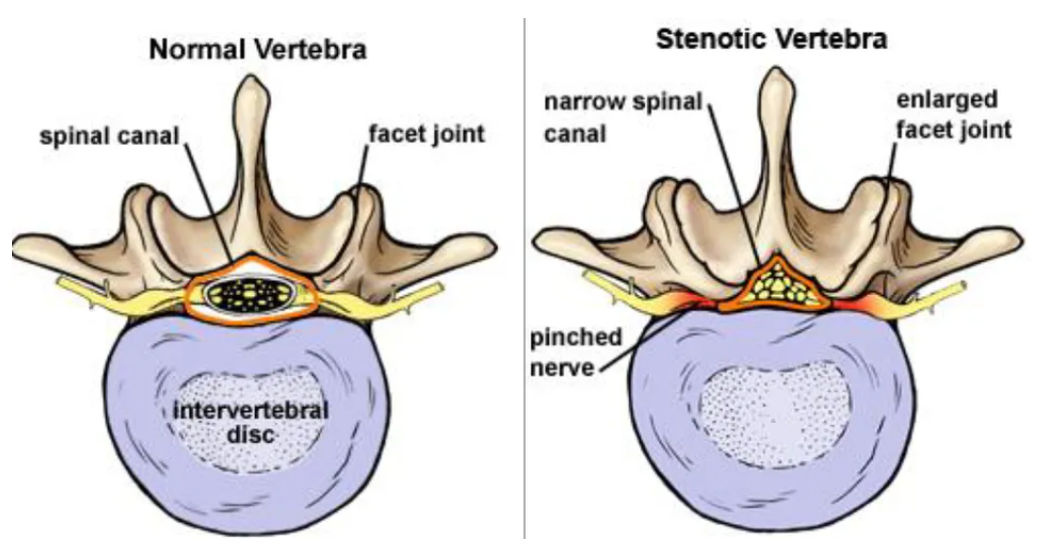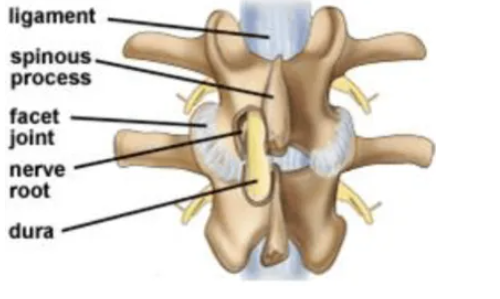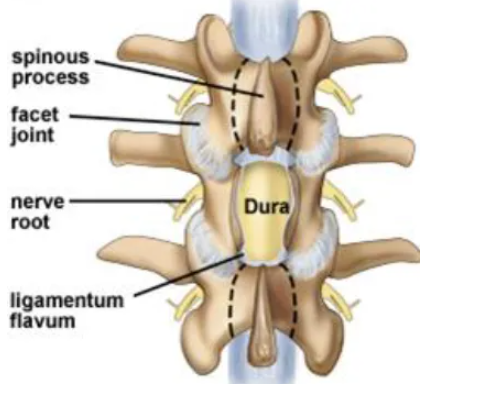Laminotomy & Laminectomy
Decompression surgery (laminectomy) removes the bony roof covering the spinal cord and nerves to create more space for them to move freely. Narrowing / stenosis of the spinal canal can cause chronic pain, numbness, and muscle weakness in your arms or legs (Fig. 1). Stenosis is often caused by age-related osteoarthritis, enlarged joints, and thickened ligaments. Decompression may be recommended if your symptoms have not improved with physical therapy or medications. The surgery requires a hospital stay from 1 to 3 days and recovery takes between 4 to 6 weeks.

Figure 1. (top view of vertebra) The difference between a normal spinal canal and one with stenosis. Spinal stenosis is a degenerative disease that causes narrowing of the spinal canal, enlargement of the facet joints, stiffening of the ligaments, and bony overgrowth. As the spinal canal narrows, it presses on the spinal cord and nerves, causing them to become swollen and inflamed.
What is spinal decompression?
Spinal decompression can be performed anywhere along the spine from the neck (cervical) to the lower back (lumbar). The procedure is performed through a surgical incision in the back (posterior). The lamina is the bone that forms the backside of the spinal canal and makes a roof over the spinal cord. Removing the lamina and other soft tissues gives more room for the nerves and allows for removal of bone spurs. Depending on the extent of stenosis, one vertebra (single-level) or more (multi-level) may be involved. There are several types of decompression surgery:
Laminectomy is the removal of the entire bony lamina, a portion of the enlarged facet joints, and the thickened ligaments overlying the spinal cord and nerves.
Laminotomy is the removal of a small portion of the lamina and ligaments, usually on one side. Using this method the natural support of the lamina is left in place, decreasing the chance of postoperative spinal instability. Sometimes an endoscope may be used, allowing for a smaller, less invasive incision.
Foraminotomy is the removal of bone around the neural foramen - the space between vertebrae where the nerve root exits the spinal canal. This method is used when disc degeneration has caused the height of the foramen to collapse, resulting in a pinched nerve. It can be performed with a laminectomy or laminotomy.
Laminaplasty is the expansion of the spinal canal by cutting the laminae on one side and swinging them open like a door. It is used only in the cervical area.
In some cases, spinal fusion may be done at the same time to help stabilize sections of the spine treated with laminectomy. Fusion uses a combination of bone graft, screws, and rods to connect two separate vertebrae together into one new piece of bone. Fusing the joint prevents the spinal stenosis from recurring and can help eliminate pain from an unstable spine.
Who is a candidate?
You may be a candidate for decompression if you have:
- significant pain, weakness, or numbness in your leg or foot
- leg pain worse than back pain
- not improved with physical therapy or medication
- difficulty walking or standing that affects your quality of life
- diagnostic tests (MRI, CT, myelogram) that show stenosis in the central canal or lateral recess.
The surgical decision
Decompression surgery for spinal stenosis is elective, except in the rare instance of cauda equina syndrome or rapidly progressing neurologic deficits. Your doctor may recommend treatment options, but only you can decide whether surgery is right for you. Be sure to look at all the risks and benefits before making a decision. Decompression does not cure spinal stenosis nor eliminate arthritis; it only relieves some of the symptoms. Unfortunately, the symptoms may recur as the degenerative process that produces stenosis continues.
What happens before surgery?
You may be scheduled for pre-surgical tests (e.g., blood test, electrocardiogram, chest X-ray) several days before surgery. In the doctor’s office you will sign consent forms and fill out paperwork so that the surgeon knows your medical history (allergies, medicines/vitamins, bleeding history, anesthesia reactions, and previous surgeries). You may wish to donate blood several weeks before surgery. You should stop taking all non-steroidal anti-inflammatory medicines (Naprosyn, Advil, Motrin, Nuprin, Aleve, etc.) and blood thinners (coumadin, aspirin, etc.) one week before surgery. Additionally, stop smoking, chewing tobacco, and drinking alcohol one week before and 2 weeks after surgery as these activities can cause bleeding problems.
Patients are admitted to the hospital the morning of the procedure. No food or drink is permitted past midnight the night before surgery. An intravenous (IV) line is placed in your arm. An anesthesiologist will explain the effects of anesthesia and its risks.
What happens during surgery?
There are seven steps of the procedure. The operation generally lasts 1 to 3 hours.
Step 1: prepare the patient
You will lie on your back on the operative table and be given anesthesia. Once asleep you will be rolled over onto your stomach with your chest and sides supported by pillows. The area where the surgery is to be performed will be cleansed and prepped. If a fusion is planned and you have decided to use your own bone, the hip area will be cleansed and prepped to obtain a bone graft. If you’ve decided to use donor bone, a hip incision is unnecessary.
Step 2: incision
A skin incision is made down the middle of your back over the appropriate vertebrae (Fig. 2). The length of the incision depends on how many laminectomies are to be performed. The strong back muscles are split down the middle and moved to either side exposing the lamina of each vertebra.

Figure 2. A skin incision is made down the middle of your back and the muscles overlying the vertebrae are
dissected off the bone and moved to the side.
Step 3: laminectomy or laminotomy
Once the bone is exposed, an X-ray is taken to verify the correct vertebra.
Laminectomy: The surgeon removes the bony spinous process. Next, the bony lamina is removed with a drill or bone-biting tools. The thickened ligamentum flavum that connects the laminae of the vertebra below with the vertebra above is removed (Fig. 3). This is repeated for each affected vertebrae.
Figure 3. A laminectomy involves removal of the entire lamina and ligament. Multiple laminae can be
removed.
Laminotomy: In some cases, the surgeon may not want to remove the entire protective bony lamina. A small opening of the lamina above and below the spinal nerve may be enough to relieve compression
(Fig. 4). Laminotomy can be done on one side (unilateral) or both sides (bilateral) and on multiple vertebrae levels.


Step 4: decompress the spinal cord
Once the lamina and ligamentum flavum are removed the protective covering of the spinal cord (dura mater) is visible. The surgeon can gently retract the protective sac of the spinal cord and nerve root to remove bone spurs and thickened ligament.
Step 5: decompress the spinal nerve
The facet joints, which are directly over the nerve roots, may be undercut (trimmed) to give the nerve roots more room. Called a foraminotomy, this maneuver enlarges the neural foramen (where the spinal nerves exit the spinal canal). If a herniated disc is causing compression the surgeon will perform a discectomy.
Step 6: fusion (if necessary)
If you have spinal instability or have laminectomies to multiple vertebrae, a fusion may be performed. Fusion is the joining of two vertebrae with a bone graft held together with hardware such as plates, rods, hooks, pedicle screws, or cages. The goal of the bone graft is to join the vertebrae above and below to form one solid piece of bone. There are several ways to create a fusion. The right one for you depends on your own choice and your doctor’s recommendation.
The most common type of fusion is called the posterolateral fusion. The topmost layer of bone on the transverse processes is removed with a drill to create a bed for the bone graft to grow. Bone graft, taken from the top of your hip, is placed along the posterolateral bed. The surgeon may reinforce the fusion with metal rods and screws inserted into the vertebrae. The back muscles are laid over the bone graft to hold it in place.
Step 7: closure
The muscle and skin incisions are sewn together with sutures or staples.
What happens after surgery?
You will wake up in the postoperative recovery area, called the PACU. Your blood pressure, heart rate, and respiration will be monitored, and your pain will be addressed. Once awake you will be moved to a regular room where you’ll increase your activity level (sitting in a chair, walking).If you’ve had a fusion, a brace may need to be worn. In 1 to 2 days you’ll be released from the hospital and given discharge instructions.
Discharge instructions:
Discomfort
After surgery, pain is managed with narcotic medication. Because narcotic pain pills are addictive, they are used for a limited period (4 to 8 weeks). Their regular use may also cause constipation, so drink lots of water and eat high fiber foods. Laxatives (e.g., Dulcolax, Senokot, Milk of Magnesia) can be bought without a prescription. Thereafter, pain is managed with acetaminophen (e.g., Tylenol).
Restrictions
If you have had a fusion, do not use non-steroidal anti-inflammatory drugs (NSAIDs) (e.g., aspirin; ibuprofen, Advil, Motrin, Nuprin; naproxen sodium, Aleve) for six months after surgery. NSAIDs may cause bleeding and interfere with bone healing.
Do not drive for 2 to 4 weeks after surgery or until discussed with your surgeon.
Avoid sitting for long periods of time.
Do not lift anything heavier than 10 pounds (e.g., gallon of milk). Do not bend or twist at the waist.
Housework and yard-work are not permitted until the first follow-up office visit. This includes gardening, mowing, vacuuming, ironing, and loading/unloading the dishwasher, washer, or dryer. Postpone sexual activity until your follow-up appointment unless your surgeon specifies otherwise.
Do not smoke. Smoking delays healing by increasing the risk of complications (e.g., infection) and inhibits the bones' ability to fuse.
Activity
You may need help with daily activities (e.g., dressing, bathing) for the first few weeks. Fatigue is common. Let pain be your guide.
Gradually return to your normal activities. Walking is encouraged; start with a short distance and gradually increase to 1 to 2 miles daily. A physical therapy program may be recommended.
If applicable, know how to wear the brace before you leave the hospital. Wear for daily activities
(excluding sleep) unless instructed otherwise.
Bathing/Incision Care
You may shower 4 days after surgery unless instructed otherwise.
Staples or stitches, which remain in place when you go home, will need to be removed. Ask your surgeon or call the office to find out when.
When to Call Your Doctor
If your temperature exceeds 101° F or if the incision begins to separate or show signs of infection, such as redness, swelling, pain, or drainage.
What are the results?
Decompressive laminectomy is successful in relieving leg pain in 70% of patients allowing significant improvement in function (ability to perform normal daily activities) and markedly reduced level of pain and discomfort [1]. However, back pain may not be relieved and 17% of older adults need another operation [2]. Symptoms may return after a few years.
Decompressive laminotomy is successful in relieving back pain (72%) and leg pain (86%), and in improving walking ability (88%) [3]. Endoscopic laminotomy results in less blood loss, shorter hospital stay, and less postoperative pain medication than an open laminotomy.
The results of the surgery are largely up to you. It is important to keep a positive attitude and diligently perform your physical therapy exercises. Maintaining a weight that is appropriate for your height can significantly reduce pain. Do not expect your back to be as good as new. You need to be mindful that you’ll always have a bad back and will need to use correct posture and lifting techniques to avoid re-injury.
What are the risks?
No surgery is without risks. General complications of any surgery include bleeding, infection, blood clots, and reactions to anesthesia. If spinal fusion is done at the same time as a laminectomy, there is greater risk of complications. The following are risks that should be considered:
Vertebrae failing to fuse.
Among many reasons why vertebrae fail to fuse, common ones include smoking, osteoporosis, obesity, and malnutrition. Smoking is by far the greatest factor that can prevent fusion. Nicotine is a toxin that inhibits bone-growing cells. If you continue to smoke after your spinal surgery, you could undermine the fusion process.
Deep vein thrombosis (DVT) is a potentially serious condition caused when blood clots form inside the veins of your legs. If the clots break free and travel to your lungs, lung collapse or even death is a risk. However, there are several ways to treat or prevent DVT. If your blood is moving it is less likely to clot, so an effective treatment is getting you out of bed as soon as possible. Support hose and pulsatile stockings keep the blood from pooling in the veins. Drugs such as aspirin, Heparin, Lovenox, or Coumadin are also commonly used.
Hardware fracture. The metal screws, rods and plates used to stabilize your spine are called "hardware." The hardware may move or break before your vertebrae are completely fused. If this occurs, a second surgery may be needed to fix or replace the hardware.
Bone graft migration. In rare cases (1 to 2%), the bone graft can move from the correct position between the vertebrae soon after surgery. This is more likely to occur if hardware (plates and screws) are not used to secure the bone graft. It’s also more likely to occur if multiple vertebral levels are fused. If this occurs, a second surgery may be necessary.
Transitional syndrome (adjacent-segment disease). This syndrome occurs when the vertebrae above or below a fusion take on extra stress. The added stress can eventually degenerate the adjacent vertebrae and cause pain.
Nerve damage or persistent pain. Any operation on the spine comes with the risk of damaging the nerves or spinal cord. Damage can cause numbness or even paralysis. However, the most common cause of persistent pain is nerve damage from the disc herniation itself. Some disc herniations may permanently damage a nerve making it unresponsive to decompressive surgery. In these cases, spinal cord stimulation or other treatments may provide relief. Be sure to go into surgery with realistic expectations about your pain. Discuss your expectations with your doctor.
If you have any questions please don’t hesitate to contact us: 209-349-8429.
rEQUEST AN APPOINTMENT
Fill out to form to request an appointment. You can also ask us spine care related questions. We will get back to you ASAP.

